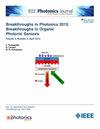High-Precision Joint Ranging Method Based on Pseudo-Random Code and Single-Tone Signal
IF 2.4
4区 工程技术
Q3 ENGINEERING, ELECTRICAL & ELECTRONIC
引用次数: 0
Abstract
In this paper, a laser joint ranging method, which integrates the pseudo-random code with the single-tone signal, is proposed for realizing high accuracy and precision. The single-tone signal utilizes a phase-shift method for high-precision ranging, while the pseudo-random code is employed to solve the distance ambiguity problem in the phase-shift method. The merging of the pseudo-random code with the single-tone signal in the digital domain and the data processing in the digital domain achieve simultaneous modulation and simultaneous ranging, which ensures the complete synchronization of the two signals during both transmission and processing. Furthermore, the pseudo-random code is band-limited, which ensures that the pseudo-random code signal and the single-tone signal do not overlap spectrally, thus preventing interference between them. The experimental results indicate that the ranging accuracy is 59.84基于伪随机码和单音信号的高精度联合测距方法
本文提出了一种将伪随机码与单音信号相结合的激光联合测距方法,实现了高精度测距。单音信号采用相移法实现高精度测距,而相移法采用伪随机码解决距离模糊问题。伪随机码与数字域单音信号的合并和数字域的数据处理实现了同时调制和同时测距,保证了两个信号在传输和处理过程中的完全同步。此外,伪随机码是带限的,这保证了伪随机码信号和单音信号在频谱上不重叠,从而防止了它们之间的干扰。实验结果表明,该方法的测距精度为59.84 ${\bf \mu m}$,测距精度为14.72 ${\bf \mu m}$。最后,文章分析了单音信号和伪随机码的选择原则,为该联合测距方法中单音信号和伪随机码的选择提供参考。
本文章由计算机程序翻译,如有差异,请以英文原文为准。
求助全文
约1分钟内获得全文
求助全文
来源期刊

IEEE Photonics Journal
ENGINEERING, ELECTRICAL & ELECTRONIC-OPTICS
CiteScore
4.50
自引率
8.30%
发文量
489
审稿时长
1.4 months
期刊介绍:
Breakthroughs in the generation of light and in its control and utilization have given rise to the field of Photonics, a rapidly expanding area of science and technology with major technological and economic impact. Photonics integrates quantum electronics and optics to accelerate progress in the generation of novel photon sources and in their utilization in emerging applications at the micro and nano scales spanning from the far-infrared/THz to the x-ray region of the electromagnetic spectrum. IEEE Photonics Journal is an online-only journal dedicated to the rapid disclosure of top-quality peer-reviewed research at the forefront of all areas of photonics. Contributions addressing issues ranging from fundamental understanding to emerging technologies and applications are within the scope of the Journal. The Journal includes topics in: Photon sources from far infrared to X-rays, Photonics materials and engineered photonic structures, Integrated optics and optoelectronic, Ultrafast, attosecond, high field and short wavelength photonics, Biophotonics, including DNA photonics, Nanophotonics, Magnetophotonics, Fundamentals of light propagation and interaction; nonlinear effects, Optical data storage, Fiber optics and optical communications devices, systems, and technologies, Micro Opto Electro Mechanical Systems (MOEMS), Microwave photonics, Optical Sensors.
 求助内容:
求助内容: 应助结果提醒方式:
应助结果提醒方式:


